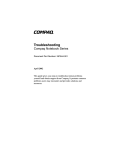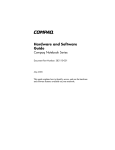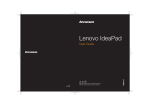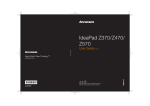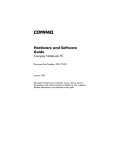Download Compaq 307502-001 Laptop User Manual
Transcript
b Startup Guide Compaq Notebook Series Document Part Number: 335401-001 September 2003 This guide explains how to set up your hardware and software, find and install the latest versions of HP software, and find additional information and support. This guide introduces you to exterior features of the notebook. © 2003 Hewlett-Packard Development Company, L.P. Microsoft and Windows are trademarks of Microsoft Corporation in the U.S. and/or other countries. SD Logo is a trademark. The information contained herein is subject to change without notice. The only warranties for HP products and services are set forth in the express warranty statements accompanying such products and services. Nothing herein should be construed as constituting an additional warranty. HP shall not be liable for technical or editorial errors or omissions contained herein. Startup Guide Compaq Notebook Series Reference Number: R3000 First Edition September 2003 Document Part Number: 335401-001 Contents 1 Hardware and Software Setup Setting Up the Hardware . . . . . . . . . . . . . . . . . . . . . . . . . Setting Up the Software . . . . . . . . . . . . . . . . . . . . . . . . . . Installing Optional Software . . . . . . . . . . . . . . . . . . . Selecting Regional Settings . . . . . . . . . . . . . . . . . . . . Selecting Screen Settings. . . . . . . . . . . . . . . . . . . . . . Protecting the Notebook from Power Surges . . . . . . Protecting the Notebook Against Viruses . . . . . . . . . Turning Off the Notebook . . . . . . . . . . . . . . . . . . . . . . . . Using the Notebook Safely . . . . . . . . . . . . . . . . . . . . . . . 1–1 1–5 1–6 1–6 1–6 1–7 1–7 1–8 1–8 2 Additional Information, Help and Updates Using the Documentation Library CD . . . . . . . . . . . . . . . Using the Help and Support Center . . . . . . . . . . . . . . . . . Contacting Technical Support . . . . . . . . . . . . . . . . . . . . . Obtaining Support Telephone Numbers . . . . . . . . . . Preparing to Call Technical Support . . . . . . . . . . . . . Installing a Retail Version of an Operating System. . . . . 2–1 2–2 2–4 2–4 2–4 2–5 3 Notebook Features Features . . . . . . . . . . . . . . . . . . . . . . . . . . . . . . . . . . . . . . Display . . . . . . . . . . . . . . . . . . . . . . . . . . . . . . . . . . . . . . . TouchPad . . . . . . . . . . . . . . . . . . . . . . . . . . . . . . . . . . . . . Top . . . . . . . . . . . . . . . . . . . . . . . . . . . . . . . . . . . . . . . . . . Power Lights . . . . . . . . . . . . . . . . . . . . . . . . . . . . . . . Keyboard and Drive Lights . . . . . . . . . . . . . . . . . . . . Startup Guide 3–1 3–1 3–2 3–3 3–3 3–4 iii Contents Power and Volume Controls . . . . . . . . . . . . . . . . . . . 3–5 Wireless On-Off Button and Application Keys. . . . . 3–6 Function and Keypad Keys . . . . . . . . . . . . . . . . . . . . 3–7 Front View . . . . . . . . . . . . . . . . . . . . . . . . . . . . . . . . . . . . 3–8 Rear View. . . . . . . . . . . . . . . . . . . . . . . . . . . . . . . . . . . . . 3–9 Left Side . . . . . . . . . . . . . . . . . . . . . . . . . . . . . . . . . . . . . 3–10 Right Side. . . . . . . . . . . . . . . . . . . . . . . . . . . . . . . . . . . . 3–12 Bottom Panel . . . . . . . . . . . . . . . . . . . . . . . . . . . . . . . . . 3–14 Index iv Startup Guide 1 Hardware and Software Setup Setting Up the Hardware CAUTION: To ensure that the correct drivers load and to prevent file corruption or damage to the components during initial setup: ■ Do not set up the notebook while it is docked in an optional HP Notebook Expansion base. ■ Run the notebook on external AC power, not on battery power, throughout initial setup. Startup Guide 1–1 Hardware and Software Setup To set up the notebook hardware: 1. Insert the battery pack: a. Place the notebook upside down and align the battery pack with the notebook battery bay. b. Slide the battery pack into the battery bay until it is seated. (For more information regarding battery packs, refer on the Documentation Library CD to the Hardware Guide, “Battery Packs” chapter.) Inserting the battery pack 1–2 Startup Guide Hardware and Software Setup 2. Connect the notebook to AC power: a. Place the notebook on a flat surface near an electrical outlet. b. Connect the AC adapter cable to the power connector on the notebook 1. c. Connect the power cord to the AC adapter 2. (Power cords and AC adapters vary by region and country.) d. Plug the power cord into an electrical outlet 3. (Electrical outlets vary by region and country.) Connecting the notebook to AC power Startup Guide 1–3 Hardware and Software Setup 3. Open the notebook by pressing the display release latch 1 and lifting the display 2. Opening the notebook 4. Turn on the notebook by pressing the power button 1. The power/standby light turns on 2. Turning on the notebook 1–4 Startup Guide Hardware and Software Setup After the notebook power is on: ■ The software setup prompt appears on the screen. ■ The battery light remains on while the battery pack is charging and turns off after the battery pack is fully charged. Setting Up the Software A prompt to set up your software is displayed on the screen when the notebook is turned on for the first time. Before responding to the prompt and proceeding through the online instructions, read the following caution and other installation information. Ä CAUTION: To prevent file corruption and to be sure that the correct device drivers install during software setup: ■ Do not unplug the notebook from the electrical outlet. ■ Do not shut down the notebook. ■ Do not remove or insert a drive. ■ After you begin the software setup, you must complete the entire process without interruption. Setup time varies. ■ If you are prompted to select a language, choose carefully. The languages that you do not choose are deleted from the system and cannot be restored during the installation. ■ When you are prompted to accept the End User License Agreement, you must choose Accept to continue the software setup. Startup Guide 1–5 Hardware and Software Setup Installing Optional Software You can install third-party software or preloaded utilities at any time after initial setup is complete. ■ To install a third-party application, refer to the documentation included with the application. ■ To install a preloaded application, select Start > All Programs > Software Setup. A setup wizard loads, and a list of applications is displayed. Select the application you want to install, and follow the instructions on the screen. view the descriptions and space requirements of preloaded ✎ Toutilities without installing them, select Start > All Programs > Software Setup, and, after viewing the utility information, select Cancel. Selecting Regional Settings Keyboard language and other regional preferences, such as time, date, and currency format, are set in the operating system. To access regional settings, select Start > Control Panel > Date, Time, Language, and Regional Options icon. For information about selecting regional settings, open the Regional Options window, then use context-sensitive Help. To use context-sensitive Help, select the question mark button in the upper-right corner of the window, then select an item. A definition, explanation, or procedure is displayed. Selecting Screen Settings If you would like to see more items on your screen or to change the size of items displayed on the screen, you can change the screen resolution setting in your operating system. To access the screen resolution settings, select Start > Control Panel > Appearance and Themes icon > Change The Screen Resolution task > Settings tab. 1–6 Startup Guide Hardware and Software Setup Protecting the Notebook from Power Surges To protect the notebook from the power surges that may be caused by an unreliable power supply or an electrical storm: ■ Plug the notebook power cord into an optional, high-quality surge protector. ■ Provide surge protection for the cable that connects the modem to the telephone jack. ■ During an electrical storm, run the notebook on battery power or shut down the notebook and disconnect the power cord. Surge protectors are available from most computer or electronics retailers. Protecting the Notebook Against Viruses When you use the notebook for e-mail, network, or Internet access, you expose the notebook to computer viruses. Computer viruses can disable the operating system, your applications, or your utilities or cause them to function abnormally. Antivirus software can detect most viruses, destroy them, and, in most cases, repair any damage they have caused. Your notebook may come preinstalled with Norton AntiVirus software. For more information about using this software: ■ Refer to the online Help file within the Norton AntiVirus software. ■ Refer to the notebook’s online Help and Support Center by selecting Start > Help and Support. To provide protection against newly discovered viruses, antivirus software must be updated frequently. For more information about virus updates for the Norton AntiVirus software, refer to the Web site at http://www.symantec.com. Startup Guide 1–7 Hardware and Software Setup Turning Off the Notebook Whenever possible, shut down the notebook by following the appropriate Windows shutdown procedure: To shut down the notebook: » Select Start > Shut Down > Shut down. For information about conserving power, setting power preferences, and using Standby and Hibernation, refer to the “Power” chapter in the Software Guide on the Documentation Library CD. Using the Notebook Safely This equipment has been tested and found to comply with the limits for a Class B digital device, pursuant to part 15 of the FCC Rules. For more safety and regulatory information, as well as instructions for protecting the notebook against electrostatic discharge, refer on the Documentation Library CD to the Regulatory and Safety Notices. This CD is included with your notebook. Å 1–8 WARNING: To reduce the risk of electric shock or damage to your equipment: ■ Plug the power cord into an electrical outlet that is easily accessible at all times. ■ Disconnect power from the product by unplugging the power cord from the electrical outlet. ■ If provided with a three-conductor power cord having a three-pin attachment plug, plug the cord into a grounded (earthed) outlet. Do not disable the power cord grounding pin. The grounding pin is an important safety feature. Startup Guide Hardware and Software Setup Å Å WARNING: To reduce the risk of serious injury, read the Safety & Comfort Guide. It describes proper workstation setup, posture, and health and work habits for computer users, and provides important electrical and mechanical safety information. This guide is located on the Web at http://www.compaq.com/ergo, on the hard drive, or on the Documentation Library CD that is included with the product. WARNING: This notebook is designed to run demanding applications at full power. As a result of increased power consumption, it is normal for the notebook to feel warm or hot when used continuously. To avoid potential discomfort or burns, do not block the air vents or use the notebook on your lap for extended periods. The notebook complies with the user-accessible surface temperature limits defined by the international Standard for Safety of Information Technology Equipment (IEC 60950). Startup Guide 1–9 Hardware and Software Setup 1–10 Startup Guide 2 Additional Information, Help and Updates Using the Documentation Library CD For supplementary information about the notebook, refer to the Documentation Library CD. The Documentation Library CD included with all models includes the guides described in the following list. Additional guides—for example, instruction manuals for using an optional wireless device—are included with select models. ■ Hardware Guide—contains information specific to your notebook. The guide includes an illustrated reference to all exterior components and steps for replacing battery packs, using keyboard features and drives, connecting external equipment, and upgrading the notebook. ■ Software Guide—describes software, including details about power and security features. ■ Modem and Networking guide—provides details about modem connections and equipment. ■ Maintenance, Shipping and Travel guide—describes steps for notebook maintenance and guidelines for using the notebook internationally. ■ Troubleshooting guide—includes solutions for common problems encountered by users. Startup Guide 2–1 Additional Information, Help and Updates ■ Regulatory and Safety Notices—includes governmental agency information. ■ Safety & Comfort Guide—describes the best ways to set up a safe and comfortable work environment, including ergonomic and safety information. To view a guide: 1. Insert the Documentation Library CD into a CD drive. 2. Select the guide you want to read from the reference library menu. 3. If prompted, accept the Adobe Acrobat Reader license agreement or install Acrobat Reader by following the instructions on the screen. Using the Help and Support Center Installed on your notebook desktop is the Help and Support Center that provides a comprehensive online resource tool for contacting an Compaq support specialist, for downloading the latest software driver updates and product information, and for learning more about using and maintaining your notebook. For example, in Help and Support, you can: 2–2 ■ Learn how to use the software tools for working with your favorite music, video, games, and photos (select models). ■ Get information about Windows XP for customizing your notebook. ■ Set up your notebook for networking and for communicating on the Web. ■ Use administration tools to manage areas such as passwords, file backups, system restore, and user accounts. ■ Learn how to print, fax, run performance and maintenance tools, and install and configure new hardware. ■ Fix and troubleshoot common notebook problems. Startup Guide Additional Information, Help and Updates ■ Protect your notebook files by using Norton AntiVirus software. ■ Undo changes to your notebook with System Restore. ■ Improve performance of your hard drive and battery. ■ Contact an Compaq support specialist or use Remote Assistance to get additional help. ■ Download the latest drivers, utilities, software updates, and product documentation for your notebook. ■ Use Tools to view notebook information and diagnose problems. ■ Keep your notebook up-to-date with Windows Update. ■ Find compatible hardware and software. To access the online Help and Support Center: 1. Press the fn+f1 hotkey or select Start > Help and Support. 2. Follow the on-screen directions to select the online Help and Support Center feature that you need. Startup Guide 2–3 Additional Information, Help and Updates Contacting Technical Support Obtaining Support Telephone Numbers If you cannot solve a notebook problem by using the online Help and Support Center installed on your notebook or the documentation included with the notebook, you may need to contact Compaq. To obtain a list of worldwide customer support telephone numbers or to locate the Compaq office near you, use one of the following methods: ■ Select Start > Control Panel > Performance and Maintenance > System icon. Then, near the lower edge of the System Properties window, select the Support Information button. ■ Refer to the Worldwide Telephone Numbers booklet (English only) included with your notebook to contact a Compaq authorized dealer, reseller, or service provider. ■ Visit the Compaq Web site at: http://www.compaq.com/consumersupport Preparing to Call Technical Support To provide the fastest possible resolution of your problem, have the notebook and the following information available when you call: 2–4 ■ Product name, serial number, and product number are provided on Service ID tag affixed to the bottom of the notebook. ■ Purchase date on the invoice. ■ Conditions under which the problem occurred. ■ Error messages that have been displayed. ■ Operating system version number and registration number. ■ To display the operating system version number and registration number, select Start > System icon > General tab. ■ Brand and model of an optional printer. Startup Guide Additional Information, Help and Updates Installing a Retail Version of an Operating System A Windows operating system provided on the notebook or on a CD is optimized by Compaq to improve overall system performance. Compaq recommends that you not install a retail version in place of this operating system. Ä CAUTION: Installing a retail version of the operating system will void your notebook warranty. Startup Guide 2–5 Additional Information, Help and Updates 2–6 Startup Guide 3 Notebook Features Features Features included with your notebook may vary by geographical region and by model. The following illustrations identify the standard external features included in most notebook models. Reference the illustrations that closely match your notebook. Display Component Description Display release latch Opens the notebook. Startup Guide 3–1 Notebook Features TouchPad 3–2 Component Description 1 TouchPad Moves the pointer and selects or activates items on the screen. 2 Left and right TouchPad buttons Function like the left and right buttons on an external mouse. 3 TouchPad on-off button Turns TouchPad on or off. 4 TouchPad light On: TouchPad is enabled. Startup Guide Notebook Features Top Power Lights Component Description 1 Power button light On: Notebook is turned on. Blinking: Notebook is in Standby. Off: Notebook is off or in Hibernation. 2 Power/standby light On: Notebook is turned on. Blinking: Notebook is in Standby. Off: Notebook is off or in Hibernation. 3 Battery light On: Battery pack is charging. Blinking: Battery pack has reached a low-battery condition. Off: AC power is applied with battery pack either fully charged or not installed, or no AC power is applied. Startup Guide 3–3 Notebook Features Keyboard and Drive Lights 3–4 Component Description 1 Caps lock light On: Caps lock is on. 2 Num lock light On: Num lock or the internal keypad is on. 3 IDE (Integrated Drive Electronics) light; also referred to as hard drive/optical drive activity light On: The internal hard drive or the optical drive bay is being accessed. 4 Optical disk drive light On: The optical drive bay is being accessed. 5 5-in-1 Memory Reader light light (Select models.) On: Memory Reader is accessing an optional digital media card. Startup Guide Notebook Features Power and Volume Controls Component Description 1 When the notebook is: Power button* ■ ■ ■ Off, press button to turn on the notebook. ■ In Hibernation, briefly press button to resume from Hibernation. ✎ On, briefly press button to initiate Hibernation. In Standby, briefly press button to resume from Standby. If the system has stopped responding and Windows shutdown procedures cannot be used, press and hold the button for at least 4 seconds to turn off the notebook. 2 Mute button On: Audio is muted. 3 Volume buttons (2) Decrease and increase the system volume: ■ ■ To decrease volume, use left button. To increase volume, use right button. *This table describes default settings. For information about changing the function of the power button, refer to the “Power” chapter in the Software Guide on the Documentation Library CD. Startup Guide 3–5 Notebook Features Wireless On-Off Button and Application Keys 3–6 Component Description 1 Wireless on-off button Turns optional internal wireless device(s) on or off. 2 Windows logo key Displays Windows Start menu. 3 Applications key Displays shortcut menu for items beneath the pointer. Startup Guide Notebook Features Function and Keypad Keys Component Description 1 fn key Combines with the function keys to perform additional system and application tasks. For example, pressing fn+f8 increases screen brightness. 2 Function keys (11) Performs system and application tasks. When combined with the fn key, function keys f1 through f12 perform additional tasks as hotkeys. (The f2 function key is not used.*) 3 Keypad keys (15)* Can be used like the keys on an external numeric keypad. *Refer to the “TouchPad and Keyboard” chapter in the Hardware Guide on the Documentation Library CD. Startup Guide 3–7 Notebook Features Front View 3–8 Component Description 1 Stereo speakers (2) Produce stereo sound. 2 Power/standby light On: Notebook is turned on. Blinking: Notebook is in Standby. Off: Notebook is off or in Hibernation. 3 Display release latch Opens the notebook. 4 IDE (Integrated Drive Electronics) light; also referred to as hard drive/optical drive activity light On: The internal hard drive or optical drive bay is being accessed. 5 Battery light On: Battery pack is charging. Blinking: Battery pack has reached a low-battery condition. Off: AC power is applied with battery pack either fully charged or not installed, or no AC power is applied. 6 Wireless on-off button Turns optional internal wireless device(s) on or off. Startup Guide Notebook Features Rear View Component Description 1 DC power connector Connects an AC adapter. 2 Exhaust vent Allows airflow to cool internal components. Additional vents are on the bottom panel of the notebook. Ä To prevent overheating, do not obstruct the vent. Do not allow a hard surface, such as an adjoining printer, or a soft surface, such as bedding or clothing, to block airflow. 3 External monitor connector Connects an optional external monitor or overhead projector. 4 Parallel connector Connects an optional parallel device, such as a printer. 5 RJ-11 jack (select models) Connects the modem cable. (Select models.) Startup Guide 3–9 Notebook Features Left Side Component Description 1 Security cable slot Attaches an optional security cable to the notebook. 2 5-in-1 Memory Reader and light (select models) Supports 5 optional digital media formats: SD, MMC, SmartMedia, Memory Stick, and Memory Stick Pro. Light On: Slot is accessing a digital media card. 3 PC Card slot (1 or 2 slots, select models) Supports an optional Type I or Type II 32-bit (CardBus) or 16-bit PC Card. 4 PC Card eject button (1 or 2 buttons, select models) Ejects an optional PC Card from the PC Card slot. (Continued) 3–10 Startup Guide Notebook Features Component Description 5 USB connectors (2) Connects an optional USB device, such as a printer. 6 Three drive configurations: optional HP USB Digital Bay, optional diskette drive, no drive Digital Bay: Supports optional pocket-sized HP USB Digital Drive. Diskette drive: Supports standard 1.4 MB diskette. No drive: No drive bay is installed. 7 One of 4 optical drive bay configurations CD-ROM, DVD-ROM, DVD+RW, or DVD/CD-RW combo drives. DVD+RW drives and DVD/CD-RW combo drives can write to both recordable CDs and DVDs. (Type of drive varies by model.) Startup Guide 3–11 Notebook Features Right Side Component Description 1 Wireless LED On: At least one optional internal wireless device is active. Off: No wireless device is active. 2 Volume buttons (3) and audio mute light Decrease, mute, and increase the system volume: ■ ■ ■ To decrease volume, use left button. ■ Light on: Audio is muted. To increase volume, use middle button. To mute or restore volume, use right button. 3 Audio-out headphone jack Connects an optional headphone, headset, or powered stereo speakers. Also connects the audio function of an audio/video device, such as a television or VCR. 4 Audio-in microphone jack Connects an optional external microphone. (Continued) 3–12 Startup Guide Notebook Features Component Description 5 USB connector Connects an optional USB device, such as a printer. 6 1394 connector (select models) Connects an optional IEEE 1394 device, such as a camcorder. 7 Infrared port (select models) Provides wireless communication between the notebook and an optional IrDA-compliant device. 8 Expansion port Connects optional HP Notebook Expansion bases. 9 RJ-45 network jack Connects an optional network cable. - S-Video-out jack Connects an optional S-Video device, such as a television, VCR, camcorder, overhead projector, or video capture card. Startup Guide 3–13 Notebook Features Bottom Panel Component Description 1 Battery bay Holds the battery pack. (Battery type and shipment mode vary by model.) 2 Exhaust vents Allows airflow to cool internal components. Ä To prevent overheating, do not obstruct the vent. Do not allow a hard surface, such as an adjoining printer, or a soft surface, such as bedding or clothing, to block airflow. 3 Hard drive bay Holds the primary hard drive. 4 Memory compartment Contains 2 memory slots, one of which is accessible for an optional 128-MB, 256-MB, 512-MB, or 1024-MB memory module upgrade. As shipped, the memory slot may be filled with a replaceable memory module, or it may be vacant, depending on the notebook model. 5 Battery release latch Releases the battery pack from the battery bay. 3–14 Startup Guide Index A AC adapter 1–3 AC power 1–3 Adobe Acrobat Reader 2–2 antivirus software 1–8 B battery inserting 1–2 light 1–5 battery bay 3–14 battery light 3–3, 3–8 battery release latch 3–14 bottom components 3–14 buttons PC Card eject 3–10 power 1–4, 3–5 volume 3–5, 3–12 wireless 3–6, 3–8 C cables AC adapter 3–9 caps lock light 3–4 connectors 1394 3–13 DC power 1–3, 3–9 docking 3–13 external monitor 3–9 Startup Guide parallel 3–9 USB 3–13 See also infrared port; jacks contacting support 2–3 technical support 2–3 customer support 2–4 D DC power connector 1–3 display 3–1 component location 3–1 opening 1–4 release latch 1–4 settings 1–6 docking connector 3–13 Documentation Library CD 2–2 drive light 3–4 drivers 1–1 drives diskette 3–11 HP USB Digital Drive 3–11 E electric shock warning 1–8 End User License Agreement 1–5 exhaust vent 3–9, 3–14 expansion port 3–13 external monitor connector 3–9 Index–1 Index F FCC notice 1–8 features 3–1 function keys 3–7 H hard drive bay 3–14 hardware display components 3–1 front components 3–8 left side components 3–10 rear panel components 3–9 right side components 3–12 top components 3–4 Hardware Guide 2–1 headphone jack 3–12 Help and Support Center 2–2 Hibernation exiting 3–5 initiating 3–5 keys function 3–7 keypad 3–7 Quick Launch 3–6 Window logo 3–6 Windows application 3–6 L languages 1–5 left side components 3–10 license, software 1–5 lights battery 1–5, 3–3, 3–8 caps lock 3–4 drive 3–4 IDE 3–8 keyboard 3–4 num lock 3–4 power/standby 1–5, 3–3, 3–8 wireless 3–12 I M IDE light 3–8 infrared port location 3–13 See also connectors; jacks Maintenance, Shipping and Travel guide 2–1 memory compartment location 3–14 Memory Reader 3–10 microphone jack 3–12 Modem and Networking guide 2–1 J jacks headphone 3–12 microphone 3–12 RJ-11 telephone 3–9 RJ-45 network 3–13 S-Video-out 3–13 K keyboard light 3–4 keypad keys 3–7 Index–2 N Norton AntiVirus 1–7 num lock light 3–4 O opening the notebook 1–4 optical drive bay configurations 3–11 Startup Guide Index P parallel connector, identifying 3–9 PC Card 3–10 power button 1–4 power cord 1–3 power features power button 3–5 power/standby light 3–3 power, AC 1–3, 1–4, 1–8 power/standby light 3–8 problems and solutions 2–1 protection against viruses 1–8 R regional settings 1–6 regulatory information notices 1–8 Regulatory and Safety Notices 2–2 release latch 1–4 right side components 3–12 RJ-11 telephone jack 3–9 RJ-45 network jack 3–13 S Safety & Comfort Guide 2–2 safety considerations 1–7 screen settings 1–6 security cable slot 3–10 Service ID tag 2–4 software Adobe Acrobat Reader 2–2 antivirus 1–8 installing 1–6 license 1–5 Norton AntiVirus 1–7 setup 1–5 Startup Guide Software Setup utility 1–6 space requirements 1–6 Software Guide 2–1 Software Setup utility 1–6 speakers internal stereo 3–8 Standby exiting 3–5 power/standby light 3–3 S-Video-out jack 3–13 system drivers 1–1 T technical support 2–4 telephone numbers, service and support 2–4 Troubleshooting guide 2–1 turning the notebook on/off 1–4, 1–8 U USB connectors 3–13 V vent 3–9, 3–14 W Web site 2–4 Windows logo key 3–6 wireless button 3–6, 3–8 wireless LED 3–12 Index–3







































